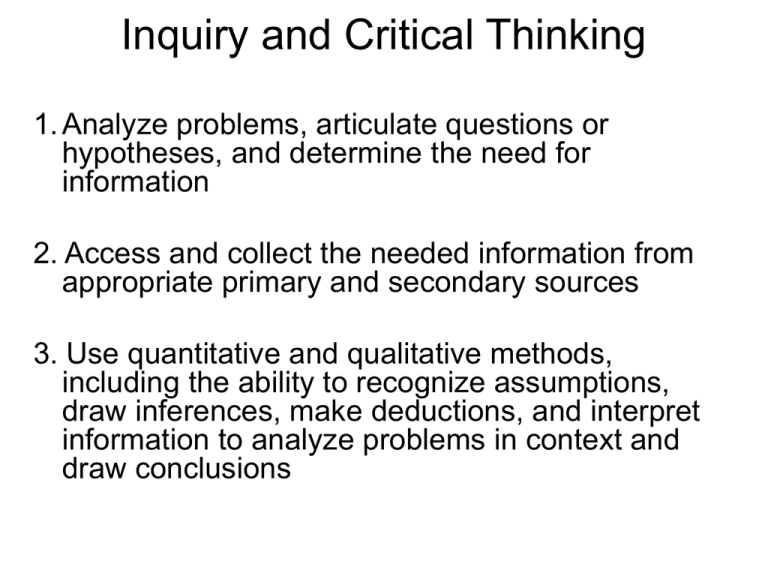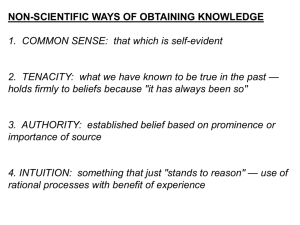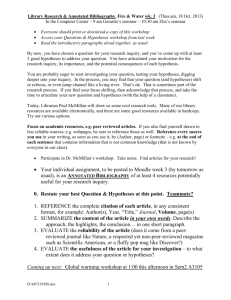Lecture 7
advertisement

Inquiry and Critical Thinking 1. Analyze problems, articulate questions or hypotheses, and determine the need for information 2. Access and collect the needed information from appropriate primary and secondary sources 3. Use quantitative and qualitative methods, including the ability to recognize assumptions, draw inferences, make deductions, and interpret information to analyze problems in context and draw conclusions Inquiry and Critical Thinking 4. Recognize complexity of problems and identify different perspectives from which problems and questions can be viewed 5. Evaluate and report on conclusions, use results to make judgments and guide actions, and identify areas where further inquiry is needed 6. Identify, analyze, and evaluate reasoning and construct and defend reasonable arguments and explanations NON-SCIENTIFIC WAYS OF OBTAINING KNOWLEDGE 1. COMMON SENSE: that which is self-evident 2. TENACITY: what we have known to be true in the past — holds firmly to beliefs because "it has always been so" 3. AUTHORITY: established belief based on prominence or importance of source 4. INTUITION: something that just "stands to reason" — use of rational processes with benefit of experience 5. METAPHYSICS: investigates principles of reality (visible and invisible), the essence of things. Construct theories on the basis of a priori knowledge, that is, knowledge derived from reason alone. 6. RATIONALISM: criterion of truth is not sensory but intellectual and deductive. COMMON ERRORS IN HUMAN INQUIRY 1. INACCURATE OBSERVATION 2. OVERGENERALIZATION 3. SELECTIVE OBSERVATION 4. MADE-UP INFORMATION 5. ILLOGICAL REASONING 6. EGO-INVOLVEMENT IN UNDERSTANDING 7. PREMATURE CLOSURE OF INQUIRY 8. MYSTIFICATION OF RESIDUALS Stone’s Policy Paradox • Our understanding of policy problems and solutions are often based on narrative stories or symbols, not systematic, empirical analysis • What type of policy stories are often told? • Story of decline – Stymied progress – Change is only an illusion – Helplessness and control • Conspiracy • Blame the victim • Synecdoche – The whole is represented by a part – Anecdotes • Metaphor – War on terror, epidemic, “Nazi” The Scientific Method • The social sciences have adopted the scientific method as a way of “knowing” – Empirical (rather than normative) – Objective (rather than subjective) – Systematic (rather than haphazard) – Rigorous (rather than hasty) This method has evolved from a very long debate about truth and knowledge. • Socrates (469-399 BCE): “I know that I know nothing” • Aresilaus (314-241 BCE) said he was not even certain that he was uncertain. • Carneades (213-128 BCE) knowledge and truth is impossible. • Sextus Empiricus (CE 200) science based on reason or logic is not to be trusted. Experiences is our best guide. • Pyrrho (365-275 BCE): one must neither trust nor reject your senses. Science and the Scientific Method • This class, and much of our field, assumes that the scientific method is the best method for answering questions in the physical, social, and political world. • Not everyone is convinced that the scientific method is obtainable or appropriate, but before you reject the approach you must first master it. Critics of the Scientific Method in the Social Sciences Post-positivists • Objectivity is impossible • Observations are skewed by your perceptions • Knowledge is still often based on authority • Subjectivity and values are not necessarily a bad thing • Pluralism, Democracy, Marketplace of ideas Applying the Scientific Method • • • • • • • Defining the problem/research question Develop theories, hypotheses, predictions Develop models Determining the information/data needed Choose method of analysis Interpret results/findings Summary/Conclusion: i.e., reject or accept hypothesis Policy Analysis • • • • • Goals of the Analysis Identify the alternative courses of action Forecast the consequences of alternatives Compare and evaluate possible outcomes Choose the most preferred alternative Goals of Analysis • Stadium Example: – Is it a “good idea”? – Will it improve the social welfare? – Will it produce a social surplus? – Will the benefits outweigh the costs? – Specific hypotheses: it will increase sales tax revenue; housing values; economic development in downtown. Identify Alternatives • Stadium Example: – Build, not to build? – Where to build? – Type of facility • Domed, multi-purpose facility, football, baseball Forecast Consequences • Stadium Example: – What will be the costs? – What will be the benefits – What will be the unintended consequences – Who will be the winners, losers Systematically Compare/Evaluate Alternatives • • • • Aggregate information for each alternative Summarize costs and benefits requires analysis and interpretation Quality of evaluations depends on reliability and validity of data, as well as the model and analytic technique. Final Recommendation • Decision Criteria: – Utilitarian – Pareto Principle – Kaldor-Hicks – Rawlsian Challenge





